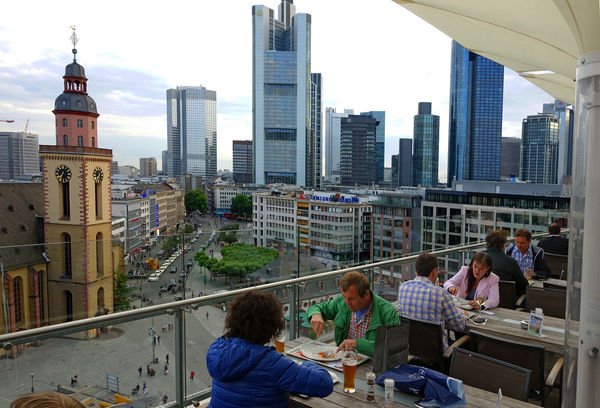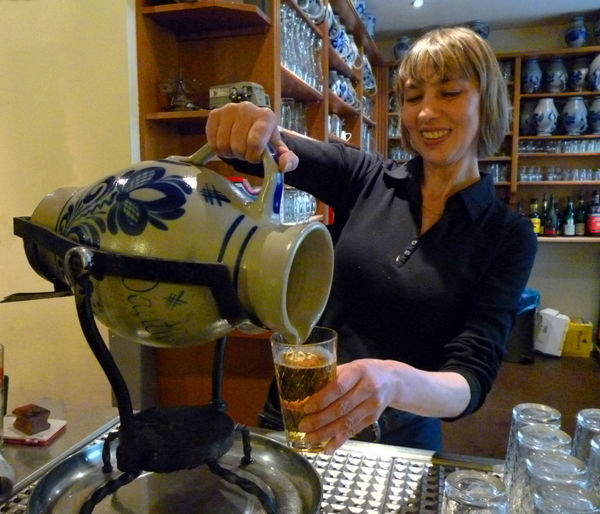Exploring Frankfurt, Germany’s Urban Hub
Even a short visit reveals this financial center to be an inviting city of striking architecture, worthwhile museums, and pleasant people zones.
By Rick Steves

Though few tourists spend any time sightseeing in Frankfurt, plenty pass through — whether to use the city's airport or while linking the wine-and-castles stretch of the Rhine to the north with the fairy-tale Romantic Road to the south. Admittedly, this trade and banking capital isn't remotely cute or quaint. But even a two- or three-hour stopover in the city center — just a 12-minute train ride from its airport — can make for an enjoyable, memorable visit.
Frankfurt doesn't make a good first impression on anyone arriving by train — the area near the station is where the city tries to contain and control its sex-and-drugs scene. But the Metro or a short walk gets you quickly to top museums, pedestrian shopping streets, and grassy riverbanks.
Ever since the early Middle Ages, when, as its name hints, Frankfurt was a good place to ford (-furt) the river, people have gathered here to trade. A pragmatic city, Frankfurt's decisions are based on what's good for business. Destroyed by WWII bombs? Take it as an opportunity to rebuild better than ever for commerce.
With its forest of skyscrapers perched on the banks of the Main River, Frankfurt has been dubbed "Mainhattan" — the city leads the country in high-rises (mostly bank headquarters). For a commanding view over the whole cityscape, ride up to the 54th floor of the Main Tower. For about $10, you can enjoy the best (and only public) city viewpoint. (For a cheaper — but still grand — city view, nurse a drink on the Galeria Kaufhof department store's rooftop.)
The city does have a handful of historic sights, mostly clustered near the Römerberg, the historic main square. This is the site of the city's first trade fairs (12th century), bank (1405), and stock exchange (1585). Opposite today's Town Hall is a cute row of half-timbered houses (rebuilt in 1983) that give you a good sense of what Frankfurt's center looked like before the square was destroyed in the war. The Frankfurt Historical Museum, nearby, is more interesting than you might expect, and features a large model of the old town as it was circa 1927.
Just beyond the Römerberg is the red sandstone St. Bartholomew's Cathedral, one of the most important buildings of the Holy Roman Empire. Emperors were elected at this church starting in 1152, and 10 were crowned here between 1562 and 1792. Little of what's standing today dates back that far, but it's still an impressive space with key bits of original medieval art, such as the 15th-century frescoes showing scenes from the life of the church's namesake saint, and the delightful altarpiece in the Chapel of Sleeping Mary, which survived the war — despite being too big to move to safety — thanks to plenty of sandbags (and luck).
Don't leave this neighborhood without visiting the Kleinmarkthalle, one of the most charming and inviting indoor market halls anywhere in Germany, and a great place for a simple lunch.
For centuries Frankfurt — the hometown of the Rothschild family and the birthplace of Anne Frank — had one of Germany's most important Jewish communities. The Jewish Museum, housed in the former Rothschild mansion, offers an engaging, sometimes heartbreaking, and sometimes uplifting perspective on Jewish life in Frankfurt from around 1800 to the present day. And near the Römerberg and cathedral, in the area that had been Europe's oldest Jewish ghetto, are several sights centered around the former site of the city's main synagogue, where the city's moving Holocaust Memorial now commemorates Frankfurt's 12,000 murdered Jews.
Art fans will want to cross the river for the Städel Museum, the most worthwhile of the nine museums lining the Main. Its enormous collection manages to feel more approachable than overwhelming, offering up a one-stop European art retrospective from the Old Masters to the present day.
If you have time for an evening stroll, take it along the same riverside promenade, called the Schaumainkai. Or visit one of Frankfurt's distinctive apple-wine pubs, which cluster a short walk inland from the riverfront. Apfelwein, drunk around here since Charlemagne's time 1,200 years ago, became especially popular in the 16th century, when local grapes were diseased. Apple wine is about the strength of beer (5.5 percent alcohol), but like wine, it can be served spiced and warm in winter. This hard cider can be an acquired taste — and you'll see locals, who've spent a lifetime learning to like it, grasping their apple wine in traditional glasses, hatched for better gripping by greasy fingers.
While you're at it, sample the culinary pride of Frankfurt: grüne Sosse, a green sauce made of sour cream blended with seven herbs, frequently served with beef, schnitzel, or hard-boiled eggs. You can also satisfy your craving for spare ribs, called Leiterchen here ("mini-ladders").
From the seedy to the sublime, from skyscrapers to apple wine, Frankfurt gives you a frank look at 21st-century Germany that's well worth your time.

